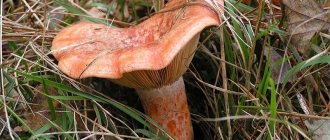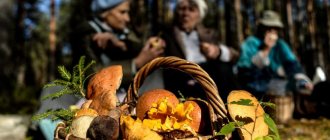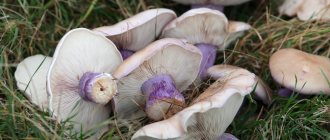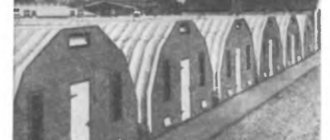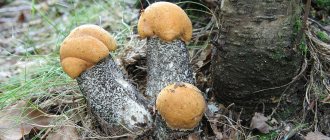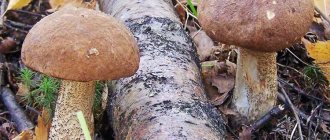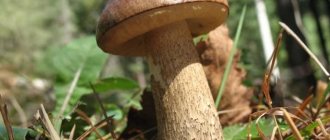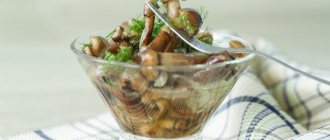The first spring or earliest mushrooms, which are collected by connoisseurs of quiet hunting, appear on European territory as early as March. Edible, as well as inedible and poisonous mushrooms form their fruiting bodies in the spring almost immediately after the snow melts in the forest.
Many species grow in thawed areas and forest edges. To be fair, it should be noted that the types of mushrooms that can be collected in early spring are very few in number, and that is why you need to know which spring mushrooms can be used for food purposes, and which varieties can cause severe poisoning.
Morel
It is considered a conditionally edible mushroom , as it requires pre-cooking for 15 minutes before further heat treatment. Raw morels do not have a distinct taste or smell, but when cooked their aroma and taste are very good.
This species can be found in deciduous and coniferous forests on the edges, between trees, in mossy and burnt areas. Prefers humus or sandy soil with sufficient moisture. You can often find morels along highways and roads, in logging areas. In general, the area should be well lit by the sun.
You can collect forest gifts from early April to early June. And if the winter is warm enough, then the first morels appear at the end of March. Sometimes colonies of mushrooms grow in September-October. However, as soon as lush greenery appears in the spring, the growth of this species ends.
Important! The most favorable time for collection is April. The growth of morels lasts only a couple of weeks, before the mass appearance of greenery, so it is important not to miss the harvest season.
The mushroom belongs to the morel family, the most common type is the common (true) morel, but there are also other types: conical and delicate morel, cap morel, thick-legged and semi-free morel. These types may differ slightly in the shape of the folds on the cap and the shape of the cap.
The cap of ordinary morels can be spherical or oblong, with numerous indentations of various shapes. The color can be different: from all shades of yellow and brown to gray-brown. The older the mushroom, the darker the cap. Its size does not exceed 5-8 cm in height and 4-8 cm in diameter. The leg grows from 3 to 9 cm, in diameter - up to 3 cm, and is colored yellow or white. The cap and stem are empty inside and form one common cavity.
Learn more about morel varieties and differences from stitches.
You can prepare any dishes from these spring mushrooms: when fried or stewed, they complement side dishes well, they can be frozen, dried, or pickled.
Video: cooking morels
Collibia, photo 2022
In the month of May, the first mushrooms are replaced by new ones, no less tasty and healthy. And although they do not stand out in size, they look very appetizing, and the pleasant aroma attracts you to them.
You can prepare collibia any way you like by performing heat treatment. It consists of several stages: cleaning, washing and boiling, draining the water.
Line
This mushroom is also conditionally edible , since when fresh it can cause severe poisoning with a fatal outcome. In the West, the mushroom is considered poisonous; in some countries it is prohibited for harvesting.
In the territory of the former Soviet Union, the mushroom could be consumed, but only with preliminary heat treatment. When cooked, it has a pleasant taste and aroma. Collection time is April-May.
Collecting and consuming autumn stitches is highly discouraged.
This species can be found in deciduous and coniferous forests, on sandy soils. Mushrooms prefer edges, clearings, places where trees have been cut down, and can be found near the road.
The line has a very unusual, expressive appearance. The cap is shapeless, very wrinkled and tortuous, resembles a walnut, empty inside, diameter is 2-10 cm. The color depends on environmental conditions and can vary from light brown to dark brown with a red tone. The leg is short and thick, diameter and height are up to 3 cm, color ranges from white to cream, hollow. The edges of the cap are connected to the stem. The pulp is white, very brittle and tender.
Important! The fungus contains a toxic substance, gyromitrin, which destroys the central nervous system, liver and gastrointestinal tract. To detoxify, raw materials need to be boiled twice for at least 30 minutes, changing the water between sessions. Under no circumstances should the broth be tasted, but rather discarded. Since gyromitrin is volatile, mushrooms can be dried for 6 months to allow the toxic substance to evaporate. Then the mushrooms can be cooked according to the recipe.
You can prepare any dishes from this type: they are great for frying and stewing, they are used for salads, side dishes with cereals, and added to meat and chicken.
Video: collecting and preparing stitches
Forests of the Moscow region
The forests of the Moscow region consist of a wide variety of tree species. But the most common of them are pine, spruce, aspen and birch. In addition, in broad-leaved forests you can find linden, maple, oak, ash, hazel, and elm trees.
Pine trees love sandy soil. As a rule, it is densely strewn with pine needles, the remains of rotted wood, and in places covered with moss. Many types of mushrooms love this substrate. Spruce trees, on the contrary, prefer moist, fertile soils, which is why moisture-loving mushroom varieties grow in spruce forests. The soil in broad-leaved forests is usually covered with aromatic, soft grass, in which you can find boletus, aspen, porcini and many other mushrooms.
May mushroom
This is an edible and safe variety of mushrooms. However, not everyone likes their specific smell and taste, which is why some simply adore this type, while others avoid it.
The smell of a fresh mushroom resembles the aroma of wet flour (mealy smell), but some note the similarity with the aroma of cucumber or herbs, the smell is very pronounced and specific. The May mushroom, as the name suggests, appears in the last month of spring. It prefers open, well-lit areas - it grows in clearings, edges of low grass, can even be found in city parks and flower beds, and is generally not picky about soil or terrain. With the onset of summer heat, the harvest season ends.
The cap and leg of this species are plain, painted whitish or cream. The cap is hemispherical in shape, with thin plates located at the bottom. The diameter can reach 3-10 cm. The leg is cylindrical, thicker at the bottom, short: in height - up to 8 cm, in diameter - up to 3 cm. The pulp is snow-white, dense, fleshy.
Stitches
In Russia you can find two types of them: ordinary and giant. Lines in forests can be seen much more often; they are more tenacious and undemanding to external conditions. Like morels, they grow under deciduous trees and also like to be found near rotting trunks, branches and stumps. The stitches are distinguished by their voluminous, irregularly shaped caps, which have deep convolutions. Their legs are also sinuous and powerful, painted grayish-white. The cap can be ocher, light brown or yellowish brown.
Raincoat
It is considered a completely edible species , but only small young specimens, which are characterized by a pleasant taste and aroma, and snow-white, elastic flesh, should be eaten.
Check out the most popular edible types of mushrooms.
Over time, the pulp loses its taste, becomes loose and turns green. Therefore, collected mushrooms cannot be stored for a long time; they must be cooked within 24 hours. Raincoats should be collected in late spring or early summer, after precipitation.
They bear fruit from the second half of May, during the summer months and until autumn. Rainflies prefer fertile soils and open areas: they can be found in meadows, fields, pastures, forest edges and clearings.
Did you know? The raincoat is considered the record holder for the release of spores: 7 trillion spores are ejected from the mushroom at a speed of 90 km/h.
There are several types of raincoats, which differ in the size and shape of the cap. For example, a giant (gigantic) raincoat is extremely large - the weight can reach 10 kg, and the hat in diameter is 30-50 cm. The hat is spherical in shape, the stem is either very short or absent. Spiky raincoats are modest in size: up to 6 cm in height, the surface is covered with small spikes up to 6 mm.
As mentioned earlier, the flesh of young representatives is snow-white, dense, but over time it loses turgor and becomes gray, purple or greenish. Only young specimens are suitable for food. They are best used for drying, frying, and stewing. They are an excellent filling for pies and complement salads and snacks. Boiling is not the most successful method of cooking, since by absorbing a lot of water, the mushrooms lose their shape.
Video: fried raincoats
Pluteus deer
It is also called deer mushroom. It prefers the northern temperate zone and deciduous forests, gardens and parks. It can grow on tree trunks, stumps, branches, loves sawdust, wood chips, and cleared areas. The mushroom can be collected from late May to mid-autumn.
The diameter of the cap can reach 15 cm, in some species it is 20-24 cm. It has a wide bell-shaped shape, which then becomes convex or flat-prostrate. There is a small bump in the center. The surface of the cap attracts with its smoothness and silkiness. It is usually dry, but in humid weather it can be slightly mucous. The cap is often gray or grayish-brown. The color is darker in the center, the edges are striped and slightly ribbed.
The pulp is brittle and soft, has a white color that does not change when cut. The pulp from the stem is tougher and more fibrous. There is practically no aroma or taste, but sometimes there is a faint radish smell.
The mushroom stem can reach 5-15 cm in length and 1-2 cm in thickness. It can be easily separated from the cap. The leg is dense, cylindrical in shape, white or whitish-gray in color. There are longitudinal brown fibers, usually lighter towards the cap.
Deer whips are necessarily subjected to heat treatment. Mushrooms can be boiled, stewed or fried. They do not have any special taste, so they are usually used for preparing complex dishes.
Sulfur-yellow tinder fungus
Refers to conditionally edible mushrooms ; before use, it requires boiling for 40 minutes or frying. Also, only young specimens that were collected not from coniferous trees, but from deciduous trees, are suitable for food.
They have a classic pleasant mushroom aroma and sour taste. This species is a wood-destroying parasite that most often affects oaks, birches, lindens, poplars and fruit trees.
It is interesting to read about other edible and poisonous mushrooms growing on trees.
In Russia and Ukraine it grows from the end of May to the end of June. The most intensive collection period occurs in mid-June. They can be found at low altitudes on trunks or stumps.
At the initial stage of development, the tinder fungus is a drop-shaped mass of rich yellow or orange color. Over time, the body of the fungus hardens, takes on a typical shape resembling an ear, and the number of pseudocaps increases. At the base, the thickness of the mushroom is 7-10 cm, the size of the caps varies from 10 to 40 cm. The caps are fan-shaped, wavy, with numerous blades. Since many large caps can be located on one leg, the mass of some representatives is 10 kg.
Did you know? Most of the mushroom is located underground and hidden from our eyes.
Mycelium can reach impressive sizes and spread over hundreds of square kilometers underground.
For example, in Oregon, a mycelium was discovered covering an area of almost 1000 hectares, weighing hundreds of tons. The tinder fungus has snow-white, brittle, tender and juicy pulp. It keeps well when frozen, and can also be used for pickling, salting and drying. Popular cooking methods are frying and stewing. The sulfur-yellow tinder fungus can be used to make minced meat for filling pies and adding to casseroles.
We advise you to familiarize yourself with the technology of preparing mushrooms: salting, pickling, drying, freezing.
Video: collecting and preparing tinder fungus
Mushroom places in the Moscow region in August will delight lovers of “silent hunting”
Another wave of mushrooms has hit the Moscow region. And if lovers of quiet hunting have already become tired of boletus, boletus and various russula, now the time has come for noble mushrooms: porcini, boletus, and boletus. Experienced mushroom pickers boast about their catches online.
Mushroom places in the Moscow region
The top of the Moscow region is usually stingy when it comes to mushrooms. Usually, while southerners carry full baskets out of the forest, northerners are content with rare chanterelles.
- But this year there is an unusual trend. Most of the so-called noble mushrooms are in the north and east, says mycologist Mikhail Vishnevsky. — Records for whites happen in the Kalinin area. There are many of them in the territory from Solnechnogorsk to the border of the Tver region. They are well collected in the Sergiev Posad area.
But there are also empty spaces. Here's what mushroom pickers are sharing on the Internet:
“I went to Lobnya. There are not enough mushrooms."
“In the Taldom region in two hours there are few chanterelles and a lot of russula.”
“Sergiev Posad district. Three buckets of whites in three hours!”
“There are a lot of mushrooms in the Fryanovo area, but all of them are chanterelles. There are no boletuses, boletuses, or boletuses.”
“I walked in front of Chernogolovka: 15 chanterelles. There is nothing beyond Chernogolovka. Mushroom-free." “We were near Krasnoarmeysk over the weekend. There are no mushrooms yet: one white and one boletus.”
Traditionally the biggest catches are here. Among the record holders is the area of Domodedovo airport. There is also something to profit from in New Moscow, Tarusa, and Podolsk.
“Domodedovo Airport: good russula - sea! Between the three of us, we collected more than 60 whites - all juicy and strong.”
“Stupino - in three hours 64 whites, a little aspen boletus and a bowl of chanterelles.”
“We collected a basket of whites in Tarusa! And most importantly, within a radius of three meters.”
“We recruited whites in Krasnaya Pakhra, New Moscow. Not on an industrial scale, of course, but enough for a good lunch and dinner.”
“Pervomayskoe. The noble ones have finally come - it’s impossible to resist.”
“Today Chekhovsky district - 73 whites, hurray!”
“Serpukhov region, attack of boletus. The young birch tree was generous with gifts.”
It is also considered rich in harvest. The most mushroom places: towards Serpukhov to the south and towards Zvenigorod to the west.
“Odintsovo district - just recently we came across only toadstools, but suddenly it’s flooded - boletus mushrooms almost jump into our hands!”
“The village of Uvarovka. It’s not enough, out of grief we salt the russula.”
“There is silence near Solnechnogorsk, except for russula and valuev, nothing, apparently, it’s still too early.”
“My mother and I went mushroom picking near the village of Artemka, Shakhovskoy district. Result: 70 whites each!”
They say there is a complete lack of mushrooms in Orekhovo-Zuevo - all chanterelles and russula. Mushroom places in Balakhna are also empty. But in the Ramensky district and Kolomna, judging by the reviews, there is something to profit from.
“I’ve already gone to Balashikha 10 times - all the mushroom places are empty.”
“There is a sea in Kolomna! In an hour we collected a full basket of boletus and white boletus.”
“We have nothing in Noginsk except chanterelles.”
Where to look for mushrooms
Experienced mushroom pickers know that mushrooms cannot be found in tall grass and dense thickets. It is simply useless to look for them there. Their habitats are considered mixed and coniferous forests
Particular attention should be paid to birch, oak, aspen, spruce and pine trees. Mushrooms are also often found on the edges of forest paths.
Experienced mushroom pickers say that you need to pick mushrooms at least 50 km from Moscow. Mushrooms tend to accumulate heavy metals. This should be taken into account when mushroom “hunting” - avoid places along roads and highways, as well as near polluting objects.
How to pick mushrooms
Mushroom “hunting” begins early in the morning, at 5-6 o’clock. It is also worth remembering that mushrooms almost always grow in groups, so if you find mushrooms in one place, be sure to look nearby for more. When searching, take your time; mushrooms are usually collected by calmly walking and carefully peering into the grass near the trees.
A successful find is not plucked, but cut off with a sharp short knife. Check the mushrooms immediately; if they are wormy, you cannot take them, it is better to leave them in the forest.
boletus
It is a completely edible mushroom, safe for consumption. It has a telling name, from which it is clear that this mushroom can be found in deciduous and mixed forests, but its favorite place to grow is birch groves. It prefers high soil and air humidity, which is why it often “settles” near water bodies and in marshy areas. You can collect boletus mushrooms from the end of May and throughout the summer. This species is highly valued for its excellent taste, composition and aroma.
This mushroom has more than 40 varieties, but the differences between them are minor. The color of the mushroom varies from light brown to gray-black. The cap size is up to 15 cm, the shape is hemispherical, and at high humidity it is covered with a mucous film. The leg can reach 3-15 cm in height, up to 4 cm in diameter, cylindrical, wider at the bottom, scaly.
The pulp of this type is white, does not have a special smell or taste, and is very soft. Mushrooms are characterized by rapid growth: a week after their appearance, they reach their maximum size and begin to age, while the flesh becomes loose, watery, and loses its elasticity. That is why only young, elastic specimens are suitable for food.
Find out more about the varieties and benefits of boletus.
Boletus has universal uses in cooking. Cooking methods include boiling, stewing, frying, and storing for the winter by salting, pickling and drying. Boletus is great for first and second courses; it can be an independent snack or an ingredient in salads. Used for filling baked goods, preparing gravy and sauces.
Video: cooking boletus mushrooms
First Gifts of Spring
A true mushroom picker always remains a mushroom picker, and the tireless thirst for quiet hunting attracts him even when a February snowstorm is blowing outside the window and snowdrifts lie like white mountains. But as soon as spring comes into its own, the ice masses will disappear, and the first grass will begin to emerge from under your feet, mushroom pickers are already trampling paths through the newly awakened forests and edges. And spring will definitely thank them for their impatience and give them their earliest mushroom gifts.
From April, among last year's leaves and dry grass, among the first timid fresh shoots, the first spring edible mushrooms will be waiting for attentive mushroom pickers. Meet them soon:
Champignon
Perhaps it is the most popular and well-known species. A very tasty and aromatic edible mushroom. It is widely grown in greenhouses, but grows under natural conditions in European territory, in the countries of Asia, Africa and America.
Prefers rich, fertile soils with high moisture content. Sometimes it can grow on the bark of trees, anthills, in vegetable gardens and parks. The collection season lasts from the second half of May until autumn.
Did you know? The first greenhouses for growing champignons appeared in France already in the 1750s.
The mushroom cap is hemispherical in shape, ranging from 6 to 16 cm in diameter, dry, and can be velvety or scaly. The leg reaches 4-10 cm, cylindrical in shape, slightly widened at the bottom, smooth, divided in the middle by a wide ring. The color of the stem and cap is the same: it can be white, cream with a slight yellowish or pinkish tint.
In young specimens the plates are snow-white, but with age they turn brown or turn brown. The pulp is tender, soft, snow-white, and turns pink in places where it is broken and pressed, as well as when oxidized in air.
It is interesting to read about champignons: benefits and harm to the body, freezing in a home refrigerator, technology for growing at home.
The most cultivated type of champignon, familiar to everyone, is Champignon (Agaricus bisporus). Edible are also two-ringed, field, ordinary, forest species. Dangerous species are the flat cap and yellow-skinned or red-skinned champignon.
Champignons can be eaten raw without any health consequences. Champignons can be prepared in any way. They are suitable for soups, broths, side dishes. They can also be fried, stewed and baked. Some people believe that champignons do not have a pronounced mushroom taste, so this type of mushroom is often prepared with the addition of spices, seasonings, herbs and garlic.
Petsitsa orange
This is another first spring mushroom. These are bright, small, orange mushrooms. Young specimens look like bowls; later they become flat, resembling plates and saucers. People call them saucers. These mushrooms are related to morels and strings. They grow right on the ground, along forest paths and on the edges. They often appear in places where there used to be fires.
Top 10 mushroom places in the Moscow region
In 2022, the following are recognized as the most mushroom places:
- Villages of Zolotilovo, Sergiev Posad district. For mushroom lovers, these predominantly deciduous forests are especially interesting: from mid-August to the end of September, you can pick honey mushrooms, chanterelles and porcini mushrooms here. You will have to search among abandoned clearings. Access to the forest border is possible.
- Mushroom place near the village of Rumyantsevo (Istrinsky district). The forest area is quite extensive. The valley is very picturesque - the forest is divided in two by the Maglusha River. There are usually a lot of mushrooms here - on both sides of the river. Closer to the banks of the river, where the soil is sandier, honey mushrooms are also found. And if you look closely, you can also find baby goats (the popular name for tubular mushrooms of the genus boletus). There are also Polish mushrooms, moss mushrooms.
- Khlyupinskoye forestry (Odintsovo district). Forest area near the village of Khlyupino. It is best to look for mushrooms near the villages of Skorotovo, Yamshchina, Nazaryevo, Uspenskoye. You can collect a basket of white or honey mushrooms.
- Forest of the village of Kolodkino (Kolomensky district). Types of mushrooms: porcini, boletus, boletus, valui, volushnushka, milk mushrooms (real and black), white mushroom, morel, russula, chanterelles, oyster mushrooms, summer and winter honey fungus. Landmarks – the village of Kolodkino is located 8 km west of the city of Kolomna. Malinskoye Highway runs 3 km north of the village.
- Mushroom places of the Beloomutsky forest (Lukhovitsky district). Beginning in the second half of August, boletuses, silver mushrooms, greenfinches, honey mushrooms and boletus mushrooms appear in the Beloomutsky forest.
- Forest near the village of Ozeretskoye (Dmitrovsky district). Mushrooms can be found on both sides of the railway: in the west, 2 km towards the village of Ozeretskoye. To the east of the station - 3 km towards the villages of Sholokhovo, Fedoskino, as well as along the banks of the Pyalovsky reservoir. In these places you can collect a good harvest of chanterelles, boletus and boletus.
- Firsanovka platform (Solnechnogorsk district). Mushrooms can be collected from both sides of the railway. In the north - 1.5 km from the platform near the villages of Bolshiye Rzhavki, Nazaryevo and further towards Klushino. In the west - 3 km from the platform across the Goretovka River towards the village of Ruzino and near Pyatnitskoye Highway.
- The most interesting mushroom route runs to the northeast from Firsanovka - you need to go to the village of Nazaryevo, and then move to the northeast. Near the village of Elino, the route will cross the Leningradskoye Highway and lead into a dense mixed forest. This is the land of boletus, white mushrooms, saffron milk caps and honey mushrooms.
- Melikhovo (Chekhov district). If you drive along the Simferopol highway in the direction of the city of Chekhov, and at the 50th km from the Moscow Ring Road turn left towards the village of Melikhovo, where the Anton Pavlovich Chekhov Museum-Reserve is located, pass Vaskino and Melikhovo itself, you can find a forest rich in mushrooms. Up to the village of Talezh, both on the left and on the right of the road, white boletuses, boletuses, aspen mushrooms, and honey mushrooms grow. According to mushroom pickers, you can definitely fill a basket in an hour.
- Platform “91st km” of the Kursk Railway (Serpukhov region). The forests of the Serpukhov region, located within walking distance from the railway stations Luch, Sharapova Okhota and Avangard, are unusually rich in both noble species of mushrooms, delicious chanterelles, and simple russula, honey mushrooms and tremors.
- "Betonka" (Serpukhov district). Along the sides of the A108 highway, passing through the Serpukhov region from the old Simferopol highway towards the urban settlement of Obolensk, there are mixed, broad-leaved and coniferous forests, where all types of summer mushrooms grow in abundance, and by autumn the trees are simply strewn with honey mushrooms.
What mushrooms grow in the Moscow region.
Obabki
Despite the fact that boletus mushrooms are usually called obabki, that is, mushrooms with brown caps, according to science it is a whole genus of mushrooms, which includes not only brown boletus mushrooms, but also all kinds of red-headed boletus mushrooms. And what’s most interesting is that there are several types of both. However, the average mushroom picker has never bothered about their diversity, and distinguishes these mushrooms only by the color of their caps. Well, because some of them are found under birches, and some - under aspens.
boletus
Since from time immemorial these mushrooms have been called little ones, we will begin our review of this group with them.
Common boletus
Captured (in all its glory) in the photo above, which headlines the gag section. It is found, of course, in birch forests, or mixed ones, but always with an admixture of birch. It can also grow in the tundra - among dwarf birches, and often has a sprout that is taller than the latter, which is why it is jokingly called “overbirch birch” among tundra inhabitants.
Appears already in June, often in the first half of the month. Continues to bear fruit for quite a long time - until the first half of October. However, everything here depends on the autumn and how early the frosts hit.
Black boletus
It is very similar to the previous species, in fact it is its complete double, differing only in a slightly darker color. But it is better not to use this as a distinctive feature, because both boletus mushrooms are prone to variations in the color of the caps in the dark or light direction. Usually mushroom pickers cannot distinguish between the two at all.
It does not bear fruit for as long as an ordinary boletus, usually from July to September. In October it can hardly be found.
White boletus
And there is one. It has the lightest color of all boletuses, and sometimes it is completely snow-white. It differs from its previous brothers in that it is drawn to damp, wetlands.
White boletuses grow from July to the end of September.
Boletus
They differ from boletus mushrooms in that they form mycorrhiza with aspen. Well, and a brighter color of the hat.
It bears fruit from early June to September; in warm autumn it can also be found in October.
Red boletus
But this fungus is absolutely indifferent to what tree it grows under. The only “requirement” is that this tree be deciduous. But most often it is found precisely in those forests where aspen grows.
Fruits from June to October. It appears en masse in three “waves”: at the end of June, in mid-July, and also in the second half of August - the first half of September.
White boletus
It turns out that among the boletus mushrooms there is also a light (up to complete whiteness) variety, which, interestingly, is sometimes considered one of the most real porcini mushrooms (unlike the white boletus mushroom discussed recently). Perhaps this is due to the excellent taste characteristics of white boletus.
It’s funny, but this mushroom avoids deciduous forests, preferring to grow among pines and spruces. I have never come across it, although they say that this mushroom is periodically encountered in the Urals.
Collection time is from June to September.
Autumn collection
The mushroom picking schedule in the autumn is no less stressful for keen mushroom pickers and mushroom eaters.
- September: all of the above summer mushrooms appear in the forest again, however, you need to be careful, because It can be difficult to see colorful caps in the bright autumn foliage.
- October: the number of mushrooms is slowly declining and in order to collect a full basket, you need to make a multi-kilometer forced march, like real soldiers. We advise you to look for relatively fresh specimens near stumps or under trees: they retain the heat that the mushroom so needs for a long time.
In October, the mushroom season practically ends.
November: by the beginning of this month the weather becomes cool. And even if you manage to find mushrooms, most likely they will be damaged by frost. These should under no circumstances be used.
What mushrooms grow
Autumn is considered the best period for collecting mushrooms precisely because they are filled with useful microelements and vitamins necessary for the body.
The most useful autumn species are considered to be: moss mushrooms, pig mushrooms, milk mushrooms and milk mushrooms, honey mushrooms, porcini mushrooms, devil's fingers, champignons (usually in the fall they are found only in warm regions, for example, in the Krasnodar Territory), trumpet mushrooms, rows and oak mushrooms.
Milk mushrooms
Quite a large group of mushrooms, which include not only real milk mushrooms from the genus Mlechnik (that is, those that produce milky juice when cut), but also a couple of representatives of the genus Russula (for example, dry milk mushrooms, which, by the way, is shown in the photo higher).
They all grow in different forests, but they prefer those that have birch (it seems like the most delicious milk mushrooms are found there).
Real milk mushroom
He is a raw milk mushroom. “The King of Mushrooms,” the hero of Russian folk tales, has been revered and respected by the people since ancient times. To this day it is considered the best mushroom for pickling. And perhaps no epithets are enough to describe the taste of salted milk mushrooms.
Found in birch forests or forests mixed with birch. Usually found in large groups. Very recognizable by the slightly pubescent edge of the cap (somewhat reminiscent of a giant white cap).
It grows from July to September, most abundantly in August.
Dry milk mushroom
He is also a white loader. Being the most authentic russula, it does not have any caustic milky juice, and therefore it can be cooked without preliminary soaking or boiling. For this quality we are no less revered by mushroom pickers than true milk mushrooms. Dry milk mushrooms are also good for pickling, although it can also be stewed in sour cream, boiled with mycelium, or fried.
It forms mycorrhiza not only with birch, but also with other trees (including conifers), so it is found in a variety of forests. Loves clearings and forest edges.
It grows from July to October, in large numbers in September.
Yellow milk mushroom
It has a slightly yellowish color on the upper part of the cap - with slight variations in the light or dark side. It can be considered a variety of real milk mushroom, because in terms of taste it is actually not inferior to it. We are also revered in our country and in Eastern Europe. But Western Europe clearly underestimated its merits; there the yellow milk mushroom is considered inedible and almost poisonous.
Unlike real milk mushrooms, it gravitates more towards coniferous trees than towards deciduous trees. Often found under spruce trees, less often in pine forests. It can be found even more rarely in a birch forest.
It grows from July to October, in large numbers in late summer and early autumn.
Black milk mushroom
He's a pig. The mushroom is very good in terms of taste, but for some reason some mushroom pickers neglect it. Suitable not only for pickling, but also for stewing or frying - with the obligatory preliminary soaking or boiling.
Just like most milk mushrooms, it breathes unevenly towards birch, so it is found in light birch forests and forests mixed with birch, preferring edges, clearings and other places well warmed by the sun.
It bears fruit from July to October, but most intensively in August-September.
Spruce mushroom
He is also a blue milk mushroom. It is named so because it quickly changes color when cut - from light yellow to purple. Outwardly similar to the yellow milk mushroom, but the color is more intense.
In terms of taste, it is almost at the same level as the real milk mushroom, and by some gourmets it is considered the best mushroom. Used purely for pickles.
Already from the name it is clear that this mushroom is found mainly in spruce forests, although it is often collected in mixed forests.
It begins to grow from the end of August. It bears fruit throughout September - until the first days of October.
Volnushka pink
The mushroom cap is round, in young ones it is convex, but over time it flattens, as a result of which a depression is formed in the center, which is called “umbilical”. There is a small amount of mucus on the surface. The skin covering the cap is equipped with thick and quite coarse-structured villi, which, arranged in circles, create the impression of a concentric pattern. It has a peculiar gray-pink color, which fades in dry weather, becoming almost white, which can lead to confusion and mushroom pickers will mistake the appearance for a white wave.
The leg is large, solid, thick and very dense. In young mushrooms it is solid; in adults, cavities appear in it. It is painted pale pink. The leg narrows towards the base. Its surface is velvety to the touch due to the fluff covering it.
Features of the summer collection
Summer representatives are considered the most valuable. In the warm season, the active mushroom season begins, so there is a real hunt for the harvest, or rather, a mushroom boom
It is important for mushroom pickers to start picking on time
All types of summer mushrooms will grow until autumn. It takes time to form a large fruiting body. But if you live in a fertile and densely populated area, you should hurry to collect exactly those most beloved and desired mushrooms.
And in August, the second wave of growth begins: mushrooms can be found almost everywhere, from undergrowth to roadsides.
We invite you to familiarize yourself with green manure for soil deoxidation
The growth characteristics of summer mushrooms are as follows.
- June or even the end of May: you will be able to find the first boletus, boletus, aspen and porcini mushrooms in the forest if the weather is warm and the soil is sufficiently moist.
- July: huge families of milk mushrooms, pine or pine mushrooms are found. These first category mushrooms are most popular in mid-summer, because their high taste qualities reach their apogee). You can also find chanterelles that have less nutritional value compared to others.
- August: autumn honey mushrooms, red mushrooms and russula appear (especially in the early period of the month).
Best articles: Review of Proplan food from Purina for cats
